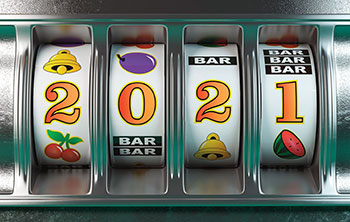A MOST SINCERE FORM OF FLATTERY
Seeing the same kinds of features in different brands of slot machines these days carries on a tradition that goes back to the beginning
By Frank Legato
 We’ve all seen them on the slot floor. Everywhere, there are new versions of features that, in the end, are very, very similar to those present in machines of more than one manufacturer. These days, trends in popular slot-machine features develop when one slot-maker releases a killer play feature and then, one by one, new versions of the same type of feature pop up under a new brand from a competing slot-maker.
We’ve all seen them on the slot floor. Everywhere, there are new versions of features that, in the end, are very, very similar to those present in machines of more than one manufacturer. These days, trends in popular slot-machine features develop when one slot-maker releases a killer play feature and then, one by one, new versions of the same type of feature pop up under a new brand from a competing slot-maker.
The latest example is the so-called “hold-and-re-spin” style of persistent feature in video slots. It started in 2014, when Aristocrat first introduced the “Lightning Link” brand of slot machines, which featured a bonus in which credit icons land and hold in place as the reels re-spin. The object is to fill the screen with the icons before the feature ends.
That feature has appeared in one form or another in the games of just about every manufacturer since then.
Imitation of successful features is nothing new. We’ve seen it happen repeatedly over the past four decades. The bonus wheel, for instance, actually appeared as a feature on a 1970’s Bally reel-spinner before it appeared as a fortune wheel (fashioned from a roulette wheel) on an early 1990’s Bally reel-spinner, Wheel of Gold, and then in its most famous incarnation in 1996 as IGT’s Wheel of Fortune, still a mainstay of slot floors.
Even the multi-line reel setups we see on all of today’s video slots are imitations of Australian-style video slots first introduced in the U.S. by Aristocrat in the 1990s, when the only video slot machines in Atlantic City and Nevada were the primitive Atari-esque three-reel versions typically used in slot tournaments.
What began as an imitation of that game style, first by WMS Gaming, then IGT, then the rest of the slot companies, quickly became the standard for all video slots by all manufacturers.
But the history of imitation in the world of slot machines goes back much farther than that. In fact, it goes back to the beginning.
The first gaming machines, as the term is now understood, were mechanical poker machines on the tops of bars in San Francisco saloons in the 1880’s. For a nickel, metallic cards would spin on spools to form a poker hand, and if it was a winner, the bartender would typically pay off in drinks or cigars. There was a heavy built-in house edge—10 cards per spool. A 50-card deck, with a couple of high cards missing.
The idea of playing automatic poker, of course, would evolve into video poker with 52 cards, but that imitation would take a lot longer than what would occur to the inventor of the machine we all know as a slot machine today. Charles Fey was a German immigrant in San Francisco in the 1890s when he invented the Liberty Bell, recognized as the father of all slot machines.
This was the first product to be referred to as a slot machine, short for “nickel-in-the-slot” machine, referring to the cost per spin. It originated the three-reel model using horseshoes, stars, card suits and the Liberty Bell as reel symbols. Pulling the spring-loaded handle could result in payouts ranging from 5 cents for two horseshoes to the top prize of 50 cents for three Liberty Bells. Fey would enjoy exclusivity in this style of game for nearly a decade, using a concept way ahead of its time in leasing the machines to bar owners in exchange for a perpetual cut of the profits.
The first imitation in the slot business would occur in 1907, and it would be much, much more brazen than modern imitations of game features like hold-and-re-spin or multiplying wild symbols. Herbert Mills, a Chicago manufacturer, simply copied Fey’s entire machine, right down to the reel symbols and even the name Liberty Bell.
By 1908,Mills Liberty Bell machines were competing with the original Fey version. Mills eventually did minor alterations like changing the reel symbols and adding a gum-vending mechanism in a version called the “Operator’s Bell,” but his slots were basically clones of the Fey version. One reason Mills was able to get away with this was that patents at the turn of the 20th century did not apply in the courts to gambling devices.
By the time Mills’ Chicago hometown became the home of the century’s most important slot supplier, Bally Manufacturing, the three- reel format invented by Fey was the standard for any gambling machine in the newly legal casino industry, and has remained so to this day for the traditional style of slot machine.
These days, of course, slot-makers face a barrage of litigation if they copy patented features too closely. However, most have become very artful at taking the idea behind a popular feature and creating a new feature that uses the concept but presents it in a totally new way. When that’s not possible, it’s not uncommon to see a slot manufacturer pay a license fee to the inventor until the patent expires. (That’s what happened with the bonus wheel, the rights for which were retained by IGT for 17 years.)
In the end, one way or another in the slot business, everything old is new again.


